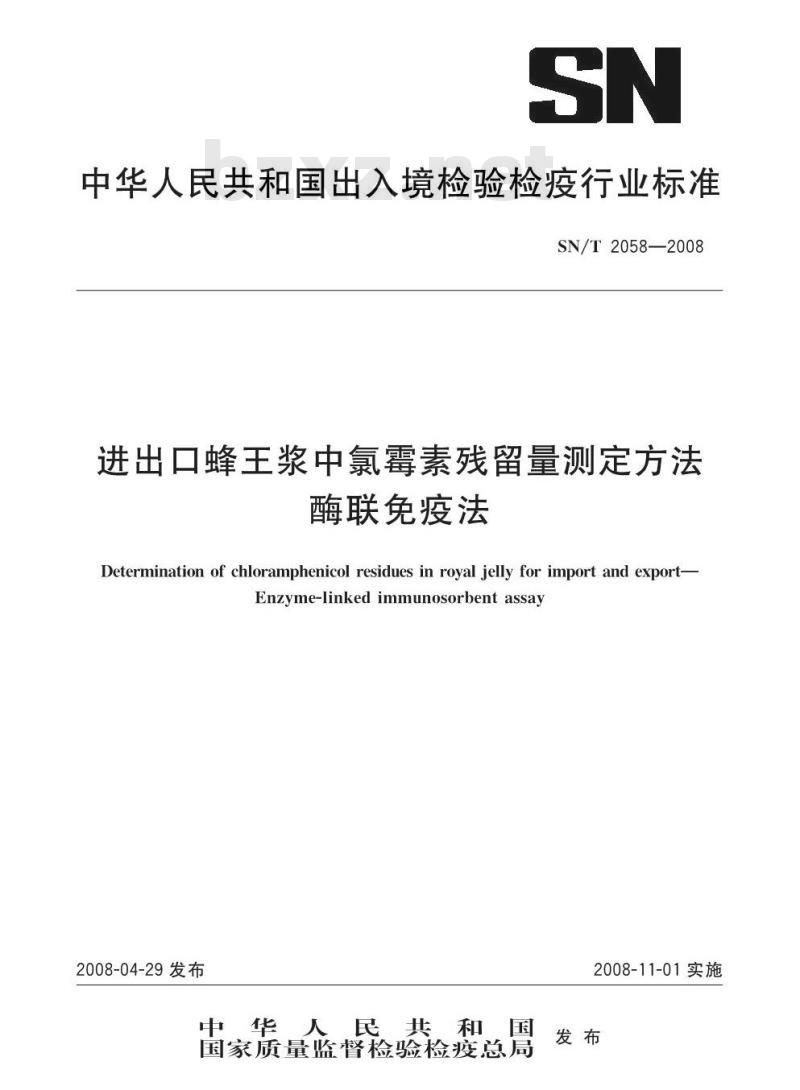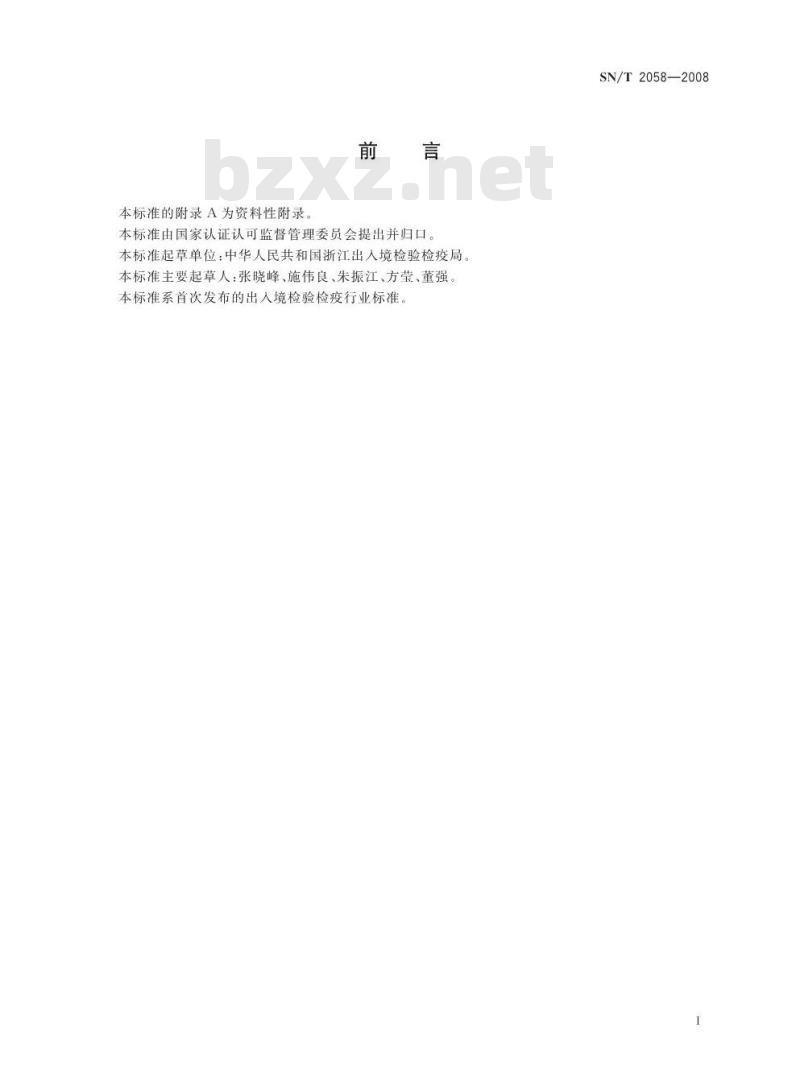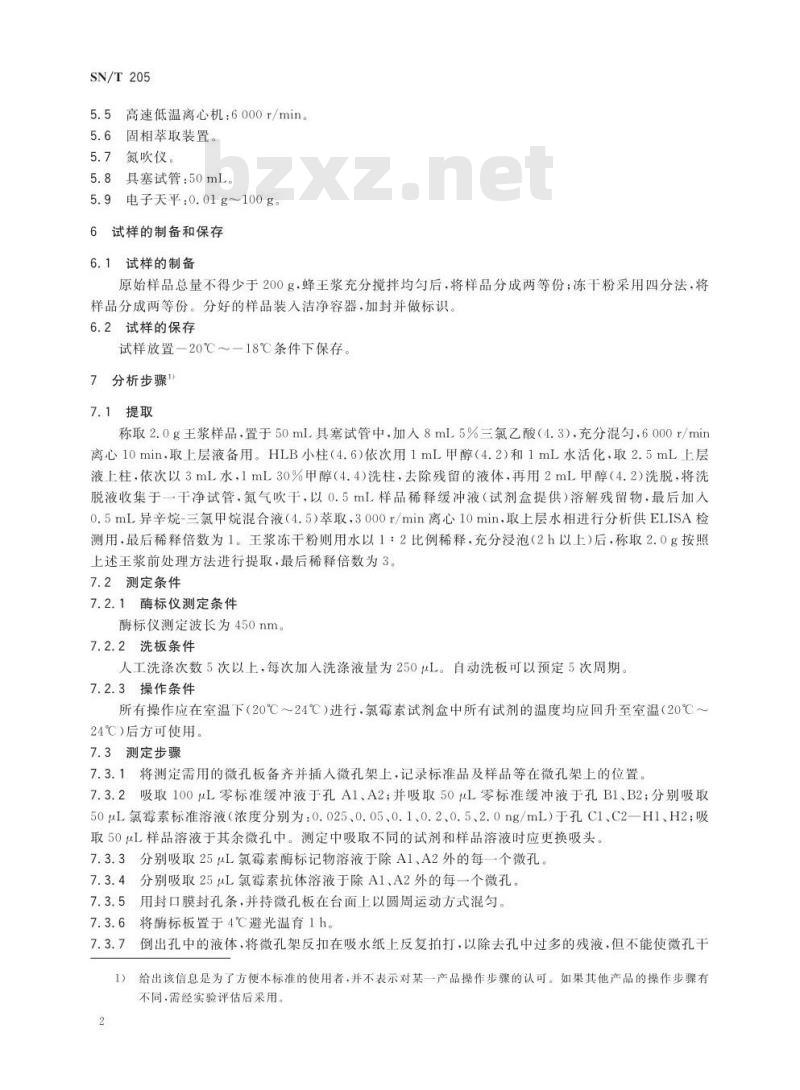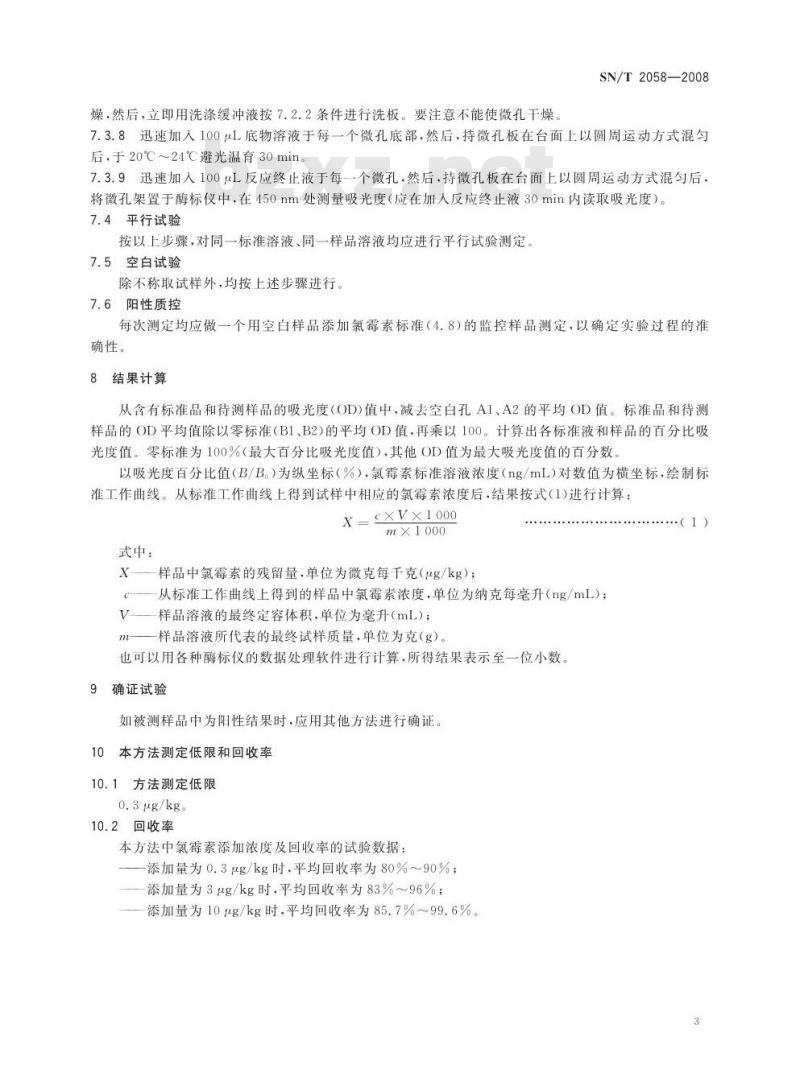- 您的位置:
- 标准下载网 >>
- 标准分类 >>
- 商检行业标准(SN) >>
- SN/T 2058-2008 进出口蜂王浆中氯霉素残留量测定方法酶联免疫法
标准号:
SN/T 2058-2008
标准名称:
进出口蜂王浆中氯霉素残留量测定方法酶联免疫法
标准类别:
商检行业标准(SN)
标准状态:
现行-
发布日期:
2008-04-29 -
实施日期:
2008-11-01 出版语种:
简体中文下载格式:
.rar.pdf下载大小:
705.01 KB
标准ICS号:
食品技术>>67.050食品试验和分析的一般方法中标分类号:
食品>>食品综合>>X04基础标准与通用方法
部分标准内容:
中华人民共和国出入境检验检疫行业标准SN/T 2058—2008
进出口蜂王浆中氯霉素残留量测定方法酶联免疫法
Determination of chloramphenicol residues in royal jelly for import and export-Enzyme-linked immunosorbentassay2008-04-29发布
中华人民共和国
国家质量监督检验检疫总局
2008-11-01实施
本标准的附录A为资料性附录。www.bzxz.net
本标准由国家认证认可监督管理委员会提出并归口。本标准起草单位:中华人民共和国浙江出入境检验检疫局。本标准主要起草人:张晓峰、施伟良、朱振江、方莹、董强。本标准系首次发布的出入境检验检疫行业标准SN/T2058—2008
1范围
进出口蜂王浆中氯霉素残留量测定方法酶联免疫法
本标准规定了蜂王浆及冻干粉中氯系残留量的酶联免疫测定方法,本标准适用于蜂王浆及冻干粉中氯霉素残留量的测定2规范性引用文件
SN/T2058—2008
下列文件中的条款通过本标准的引用而成为本标准的条款。凡是注日期的引用文件,其随后所有的修改单(不包括勘误的内容)或修订版均不适用于本标准,然而,鼓励根据本标准达成协议的各方研究是否可使用这些文件的最新版本。凡是不注日期的引用文件,其最新版本适用于本标准,GB/T6682分析实验室用水规格和试验方法(GB/T6682一1992,negISO3696:1987)3方法提要
本标准以三氯乙酸来沉淀蜂王浆中的蛋百质和提取残留的氯霉素,然后以HLB净化。微孔板中包被有绵羊抗免IgG抗体,加入特异性抗体(免抗氯霉素抗体)、酶标记氯霉素、氯霉素标准品或样品提取液后,特异性抗体与包被的绵羊抗免IgG抗体结合,同时游离氯霉素和酶标记氯霉素竞争性的与特异性抗体结合。通过洗涤除去未结合的氯霉素和酶标记氯霉素,然后加入底物显色,用酶标仪测定吸光度,根据吸光度值得出试样中氯霉素的含量。4试剂和材料
除注明外,所有试剂均为分析纯,水为GB/T6682规定的一级水。4.1氯霉素检测试剂盒(参见附录A)。4.2甲醇。
4.35%三氯乙酸:5.0g三氯乙酸以水溶解并定容至100mL。4.430%甲醇:30.0mL甲醇(4.2)以水定容至100mL。4.5异辛烷-三氯甲烷混合液:异辛烷、三氯甲烷以2:3(体积比)的比例混合4.6HLB小柱:Oasis(或相当产品).3mL(60mg)。4.7氯霉素标准品:纯度≥98%。4.8氯霉素标准品溶液的配制:称取0.01g氯霉素标准品,以甲醇定容至100mL,配制100μg/mL的工作液,于4℃~8℃条件下保存4.9空白样品:选用已确切知道不含有氯霉素的蜂王浆样品,作为空白样品。用于随样测试的加标监控实验。
5仪器
5.1酶标仪
5.28道移液器:10μL~100μL。5.3单道移液器:10μL~100μL,20μ~200μL.100μ~1000μ和2mL~10ml。5.4混合振荡器。
SN/T205
5.5高速低温离心机:6000r/min。5.6固相萃取装置。
5.7氮吹仪。
5.8具塞试管:50mL。
5.9电子天平:0.01g~100g
6试样的制备和保存
6.1试样的制备
原始样品总量不得少于200g,蜂王浆充分搅拌均匀后,将样品分成两等份:冻干粉采用四分法,将样品分成两等份。分好的样品装入洁净容器,加封并做标识。6.2试样的保存
试样放置-20℃~一18℃条件下保存。7分析步骤1
7.1提取
称取2.0g王浆样品,置于50mL具塞试管中,加人8mlL5%三氯乙酸(4.3),充分混勾,6000r/min离心10min,取上层液备用。HLB小柱(4.6)依次用1mL甲醇(4.2)和1mL水活化,取2.5mL上层液上柱,依次以3mL水,1mL30%甲醇(4.4)洗柱,去除残留的液体,再用2mL甲醇(4.2)洗脱,将洗脱液收集于二干净试管,氮气吹干,以0.5mL样品稀释缓冲液(试剂盒提供)溶解残留物,最后加人0.5mL异辛烧-三氯甲烷混合液(4.5)萃取,3000r/min离心10min,取上层水相进行分析供ELISA检测用,最后稀释倍数为1。王浆冻干粉则用水以1:2比例稀释,充分浸泡(2h以上)后,称取2.0g按照上述主浆前处理方法进行提取,最后稀释倍数为37.2测定条件
7.2.1酶标仪测定条件
酶标仪测定波长为450nm。
7.2.2洗板条件
人工洗涤次数5次以上,每次加入洗涤液量为250μL。自动洗板可以预定5次周期。7.2.3操作条件
所有操作应在室温下(20℃~24℃)进行.氯霉素试剂盒中所有试剂的温度均应回升至室温(20℃~24℃)后方可使用。
7.3测定步骤
7.3.1将测定需用的微孔板备齐并插人微孔架上,记录标准品及样品等在微孔架上的位置7.3.2吸取100μL零标准缓冲液于孔A1、A2;并吸取50μL零标准缓冲液于孔B1、B2;分别吸取50uL氯霉素标准溶液(浓度分别为:0.025、0.05、0.1、0.2、0.5、2.0ng/mL)于孔C1、C2—H1、H2;吸取50L样品溶液于其余微孔中。测定中吸取不同的试剂和样品溶液时应更换吸头。7.3.3分别吸取25uL氯霉素酶标记物溶液于除A1、A2外的每一个微孔,7.3.4分别吸取25uL氯霉素抗体溶液于除A1、A2外的每一个微孔。7.3.5用封口膜封孔条,并持微孔板在台面上以圆周运动方式混匀。7.3.6将酶标板置于4℃避光温育1h。7.3.7倒出孔中的液体,将微孔架反扣在吸水纸上反复拍打,以除去孔中过多的残液,但不能使微孔干给出该信息是为了方便本标准的使用者,并不表示对某一产品操作步骤的认可:如果其他产品的操作步骤有1)
不同,需经实验评估后采用。
燥,然后,立即用洗涤缓冲液按7.2.2条件进行洗板。要注意不能使微孔于燥SN/T2058—2008
7.3.8迅速加人100μL底物溶液于每一个微孔底部,然后,持微孔板在台面上以圆周运动方式混匀后,于20℃~24℃避光温育30min。7.3.9迅速加入100μL反应终止液于每一个微孔,然后,持微孔板在台面上以圆周运动方式混匀后,将微孔架置于酶标仪中,在450nm处测量吸光度(应在加人反应终止液30min内读取吸光度)。7.4平行试验
按以上步骤,对同一标准溶液、同一样品溶液均应进行平行试验测定。7.5空白试验
除不称取试样外,均按上述步骤进行。7.6阳性质控
每次测定均应做一个用空白样品添加氯霉素标准(4.8)的监控样品测定,以确定实验过程的准确性。
8结果计算
从含有标准品和待测样品的吸光度(OD)值中,减去空白孔A1、A2的平均OD值。标准品和待测样品的OD平均值除以零标准(B1、B2)的平均OD值,再乘以100。计算出各标准液和样品的百分比吸光度值。零标准为100%(最大百分比吸光度值),其他OD值为最大吸光度值的百分数,以吸光度百分比值(B/B。)为纵坐标(%),氯霉素标准溶液浓度(ng/mL)对数值为横坐标,绘制标准工作曲线。从标准工作曲线上得到试样中相应的氯霉素浓度后,结果按式(1)进行计算:X=cXVX1000
mx1000
式中:
X—样品中氯霉素的残留量,单位为微克每千克(μg/kg);从标准工作曲线上得到的样品中氯霉素浓度,单位为纳克每毫升(ng/mL);V—样品溶液的最终定容体积,单位为毫升(mL);m——样品溶液所代表的最终试样质量,单位为克(g)。也可以用各种酶标仪的数据处理软件进行计算,所得结果表示至一位小数。9确证试验
如被测样品中为阳性结果时,应用其他方法进行确证。10
本方法测定低限和回收率
10.1方法测定低限
0.3μg/kg。
10.2回收率
本方法中氯霉素添加浓度及回收率的试验数据:添加量为0.3μg/kg时,平均回收率为80%~90%;添加量为3μg/kg时,平均回收率为83%~96%;—添加量为10μg/kg时,平均回收率为85.7%~99.6%。.(1)
SN/T2058—2008
A.1试剂盒组成
附录A
(资料性附录)
氯霉素试剂盒(荷兰EURO-DIAGNOSTICA公司产品)2)A.1. 1
预包被抗体的96孔板:12条×8孔A.1.2
氯霉素标准溶液:0.025、0.05、0.1、0.2、0.5、2和100ng/mL重组/零标准缓冲液。
氯霉素酶标记物冻干粉:根据氯霉素试剂盒中说明,可用重组/零标准缓冲液配制成氯霉素酶A.1.4
标记物溶液
A.1.5抗氯霉素抗体冻干粉:根据氯霉素试剂盒中说明,可用重组/零标准缓冲液配制成抗氯霉素抗体溶液。
底物TMB溶液。
稀释缓冲液:可用水4倍稀释后使用。A.1.8
洗涤浓缩液:可用水10倍稀释后使用。A.1.9反应终止液。
试剂盒应在4℃~8℃避光条件下保存,溶解后的酶标记物和抗体溶液需一15℃条件冻存。A.2
标准校正曲线
标准校正曲线见图A.1。
y=-14.041lnx+18.233
c/ing/mL
标准校正曲线
2)给出该信息是为了方便本标准的使用者,并不表示对某一产品的认可。如果其他产品具有相同的效果,需经实验评估后使用这些等效产品,
Foreword
AnnexAofthis standardare informativeannexs.SN/T2058—2008
This standard was proposed by Certification and Accreditation Administration of the People's Re-public of China.
This standard was mainly drafted by Zhejiang Entry-Exit Inspection and Quarantine Bureau of thePeople's Republic of China
This standard was mainly dafted by Feng-xiao Zhang,Wei-liang Shi,Zhen-jiang Zhu,Ying FangQiangDong
This standard is professional standard of Entry-Exit inspection and quarantine promulgated for thefirsttime.
SN/T2058—2008
Determinationofchloramphenicolresiduesinroyal jelly for import and export-Enzyme-linkedimmunosorbentassayScope
This standard specifies themethods of determination byELiSA method of chloramphenicol residuesinroyal jellyandroyal jellypowder.This standard is applicable to the screen determination of chloramphenicol residues in royal jelly royaljellypowder.
2Normativereferences
Thefollowing normative documents contain provisions which,through reference in this text,con-stitute provisions of this standard.For dated references, subsequent amendments to,or revisionsof,any of these publications do not apply.However parties to agreements based on this standard areencouragedtoinvestigatethepossibilityofapplyingthemostrecenteditionsofthenormativedocu-ments indicated below.For undated references,the latest edition of the normative document re-ferredtoapplies.
GB/T6682Waterforanalytical laboratoryuse—Specificationand testmethods.(GB/T6682—1992,neqso3696:1987)
3Principle
The microtitrebased ElAkit consists of 12 strips,each8 wells,precoated with sheepantibodiestorabbit IgG. A specific antibody(rabbit anti-CAP),enzyme labelled CAP(enzyme conjugate) and CAPstandard or sample are added to the precoated wells followed by a single incubation step.The specif-ic antibodies are bound by the immobilised antibodies and at the same time free CAP (present in thestandard solutionorsample)andenzymeconjugatedCAPcompetefortheCAPantibodybinding sitea(competitive enzyme immunoassay).Afteran incubation time of 1hour,thenon-bound(enzymela-belled) reagents are removed in a washing step.The amount of CAP enzyme conjugate is visualisedby the addition of a chromogen substrate(tetramethylbenzidine,TMB).Bound enzyme conjugatetransformsthecolorlesschromogen into a coloured product.The substratereaction isstopped byphotometricallyat 45o nm.The optical density is inversely proportional to theCAP concentration inthe sample.
Reagents and materials
SN/T2058—2008
Unless otherwise specified,all the chemical reagents should be A.R.grade.\water\is the first gradewaterpreseribedinGB/T6682
Enzyme immunoassaykitforthequantitativeanalysis of CAP(seeannexA).Methanol
5% Trichloroaceticacid:Dissolve5.0gtrichloroacetic acid in100mLdistilled water.30%Methanol:Dissolve30.0mLmethanolin70mLdistilledwater.Mixtureof isooctane and trichloromethane:Mix isooctane and trichloromethane in the ratioof2 :3(V/V).
HLBcolumns:Oasis.3mL(60mg)
CAPstandard(Lyophilized):Purity≥98%The preparation of CAP standard solution(100 μg/mL):Dissolve0.01g CAP standard in100mLmethanol.
blanksimple:Select royal jelly samplenot including the CAP asblank sample.It can be used toinmonitoringtest.
Apparatus and equipment
ELISAreaderequippedwitha450nmfilter.10μL~100μLmultichannel micropipette with suitable tips.variablevolume precision micropipette withsuitabletips:10 μL~100μL,20μL~200μL,100μL~1000μLand2mL~10mL.
Sakervotex.
Centrifuge:6000 r/min.
SPEcartrige.
SN/T2058—2008
Nitrogenevaproator.
Test tube with plug:50 mL
Electronicbalance:0.01g~100gPreparationandstorageof sample6.1PreparationofsampleextractionThe wholeprimary sample should be more than 2oo g.For royal jelly samples:Divide it into two equal parts after mix well. For royal jelly powder samples:Divide it into two equal parts by quarta-tion.Thenkeeptheprepared sampleintotwo samplebottles,seal and label.6.2Storage of sample
Storesampleat-20℃~-18℃
Teststeps)
7.1extraction
Weigh 2. 0 g of royal jelly into 50 mL tube with plug.add 8 mL 5% trichloroacetic acid(4. 3),centrifuge 6 000 r/min at room temperature for 10 min.Transfer the supernatant into a clean tube.This su-pernatant is further purified as following by means of HLB columns(4.6).The columns is rinsed with1mL methanol(4.2) and equilibrated with 1 mL distilled water,2.5 mL supernatant is past though thecolumn,followed by rinsing with3mL distilled water and 1mL30%methanol(4.4).The fluid residusis remove by positive pressure,the column is dried by floating it with air or nitrogen. Then elutesample with 2 mL methanol(4. 2) and collect it into a clean tube, blew with nitrogen until to dry. Dis-solvethe residuewith0.5mLmixtureof isooctaneandtrichloromethane(4.5)and0.5mLsampledi-luting buffer(annex).After mediating,centrifuge3000r/minat roomtemperature for10 min.the su-pernatent is ready for ELisA assay.For royal jelly powder. it should be dip in water (1 : 2) at least2 h, then weigh 2. g for extraction according to royal jelly method.1)The information supplying herein is just for the convenience usage for the users of this standard and not forsome certain product's authorization analysis procedure. The testing process of another equal kits maybe dif-fer, so it should be used aft testing, evaiution andverification.8
7.2 Test condition
7.2.1Thework condition of microplatereader.Themicroplate reader should be used at a 450 nm filter.7.2.2Thework conditionof washmachineSN/T2058—2008
Manual work:All the wells must be washed manually more than 5 times.Each time inject 250 μL washsolution with multichannel micropipette.Automatism work:All the wells should be washed 5 timesbythewashmachine.
Operation condition
All the operation should be done at room temperature(20℃~24).The reagents should be brougheuptoambienttemperature(20℃~24℃)beforestartingthetest.7.3Determination
Predetermine an assaylayout,recordingblank,standard and samplepositions taking into ac7.3.1
count that all havetobe runinduplicate.Pipette100 μLof reconstitution/zero standardbufferin duplicate(wells A1,A2);Pipette7.3.2
50 μL of reconstitution/zero standard buffer in duplicate(wells B1,B2);Pipette 50 μL of each stand-ard dilution (0.025,0.05,0.1.0.2,0.5 and 2 ng/mL) in duplicate(wells C1,C2 to H1,H2.); Pipette50 μL of each sample solution in duplicate into the remaining wells of the microtitre plate. when in-jectdifferent reagentsand samplesolutions,tips shouldbereplaced.7.3.3
Add 25μL of conjugate(CAP-HRPO)into all wells,except wellsA1 and A2.Add25μLof antibodysoltionintoall wells,exceptwellsA1andA2.Seal the microtitre plate and shake the plate gently with rotating motion for few seconds toIncubatefor1hinthedarkat4℃
Discard the solution from the microtitre plate and wash5 times with rinsing buffer followingthe condition of 7.2. 2.
Pipette1oo μL of substrate solution into each well.Incubate 30 min.at room temperature7.3.8
(20℃~24℃).
SN/T2058—2008
Add 100μL of stop solutioninto each well.Read the absorbancevalues immediately at7.4Parallel test
Following the above steps.the same standards and sample solutions also should be measured at thesame time for parallel test.7.5 Blank test
Thetest should bedonefollowing theabove stepsexcept foradding samples7.6Positive monitoring
Analyze a recoveries fortified atmaximum residue limit(MRL)levelusing blank sample each test.Calculating theresult
Subtractthe mean optical density(OD)value of the blank wellsA1and A2fromthe individual OD ofthe wells containing the standards and the samples. The OD values of the standards and the samples(mean values of the duplicates)are divided by the mean OD value of the zero standard (wells B1 andB2)andmultiplyby100(B/B。);thezerostandardisthusmadeequal to100%(maximalabsorbance)andtheotherODvaluesarequotedinpercentagesofthemaximalabsorbance.Enter the B/B。values calculated for each standard in a semi-logarithmic system of coordinates a-gainst the standard CAP concentration;drawthe standard curve;Interpolatethe correspondingcon-centration from the calibration curve;Calculate the concentrations of CAP in the samples accordingto formula(1):
C×V×1000
m×1000
X-theconcentrationsofcAPinthesamplesunitinμg/kg.1)
c-theconcentrationsgottenfromthesemi-logarithmic system of coordinatesunit in ng/mL:V-thefinal volumeof thesamplesolutionunitinmL:m-thefinal sampleweightof thesamplesolutionunit ing.Otherdataprocessing software can also be used to calculate the concentrations of CAP.The resultsindicate to one decimal.
小提示:此标准内容仅展示完整标准里的部分截取内容,若需要完整标准请到上方自行免费下载完整标准文档。
进出口蜂王浆中氯霉素残留量测定方法酶联免疫法
Determination of chloramphenicol residues in royal jelly for import and export-Enzyme-linked immunosorbentassay2008-04-29发布
中华人民共和国
国家质量监督检验检疫总局
2008-11-01实施
本标准的附录A为资料性附录。www.bzxz.net
本标准由国家认证认可监督管理委员会提出并归口。本标准起草单位:中华人民共和国浙江出入境检验检疫局。本标准主要起草人:张晓峰、施伟良、朱振江、方莹、董强。本标准系首次发布的出入境检验检疫行业标准SN/T2058—2008
1范围
进出口蜂王浆中氯霉素残留量测定方法酶联免疫法
本标准规定了蜂王浆及冻干粉中氯系残留量的酶联免疫测定方法,本标准适用于蜂王浆及冻干粉中氯霉素残留量的测定2规范性引用文件
SN/T2058—2008
下列文件中的条款通过本标准的引用而成为本标准的条款。凡是注日期的引用文件,其随后所有的修改单(不包括勘误的内容)或修订版均不适用于本标准,然而,鼓励根据本标准达成协议的各方研究是否可使用这些文件的最新版本。凡是不注日期的引用文件,其最新版本适用于本标准,GB/T6682分析实验室用水规格和试验方法(GB/T6682一1992,negISO3696:1987)3方法提要
本标准以三氯乙酸来沉淀蜂王浆中的蛋百质和提取残留的氯霉素,然后以HLB净化。微孔板中包被有绵羊抗免IgG抗体,加入特异性抗体(免抗氯霉素抗体)、酶标记氯霉素、氯霉素标准品或样品提取液后,特异性抗体与包被的绵羊抗免IgG抗体结合,同时游离氯霉素和酶标记氯霉素竞争性的与特异性抗体结合。通过洗涤除去未结合的氯霉素和酶标记氯霉素,然后加入底物显色,用酶标仪测定吸光度,根据吸光度值得出试样中氯霉素的含量。4试剂和材料
除注明外,所有试剂均为分析纯,水为GB/T6682规定的一级水。4.1氯霉素检测试剂盒(参见附录A)。4.2甲醇。
4.35%三氯乙酸:5.0g三氯乙酸以水溶解并定容至100mL。4.430%甲醇:30.0mL甲醇(4.2)以水定容至100mL。4.5异辛烷-三氯甲烷混合液:异辛烷、三氯甲烷以2:3(体积比)的比例混合4.6HLB小柱:Oasis(或相当产品).3mL(60mg)。4.7氯霉素标准品:纯度≥98%。4.8氯霉素标准品溶液的配制:称取0.01g氯霉素标准品,以甲醇定容至100mL,配制100μg/mL的工作液,于4℃~8℃条件下保存4.9空白样品:选用已确切知道不含有氯霉素的蜂王浆样品,作为空白样品。用于随样测试的加标监控实验。
5仪器
5.1酶标仪
5.28道移液器:10μL~100μL。5.3单道移液器:10μL~100μL,20μ~200μL.100μ~1000μ和2mL~10ml。5.4混合振荡器。
SN/T205
5.5高速低温离心机:6000r/min。5.6固相萃取装置。
5.7氮吹仪。
5.8具塞试管:50mL。
5.9电子天平:0.01g~100g
6试样的制备和保存
6.1试样的制备
原始样品总量不得少于200g,蜂王浆充分搅拌均匀后,将样品分成两等份:冻干粉采用四分法,将样品分成两等份。分好的样品装入洁净容器,加封并做标识。6.2试样的保存
试样放置-20℃~一18℃条件下保存。7分析步骤1
7.1提取
称取2.0g王浆样品,置于50mL具塞试管中,加人8mlL5%三氯乙酸(4.3),充分混勾,6000r/min离心10min,取上层液备用。HLB小柱(4.6)依次用1mL甲醇(4.2)和1mL水活化,取2.5mL上层液上柱,依次以3mL水,1mL30%甲醇(4.4)洗柱,去除残留的液体,再用2mL甲醇(4.2)洗脱,将洗脱液收集于二干净试管,氮气吹干,以0.5mL样品稀释缓冲液(试剂盒提供)溶解残留物,最后加人0.5mL异辛烧-三氯甲烷混合液(4.5)萃取,3000r/min离心10min,取上层水相进行分析供ELISA检测用,最后稀释倍数为1。王浆冻干粉则用水以1:2比例稀释,充分浸泡(2h以上)后,称取2.0g按照上述主浆前处理方法进行提取,最后稀释倍数为37.2测定条件
7.2.1酶标仪测定条件
酶标仪测定波长为450nm。
7.2.2洗板条件
人工洗涤次数5次以上,每次加入洗涤液量为250μL。自动洗板可以预定5次周期。7.2.3操作条件
所有操作应在室温下(20℃~24℃)进行.氯霉素试剂盒中所有试剂的温度均应回升至室温(20℃~24℃)后方可使用。
7.3测定步骤
7.3.1将测定需用的微孔板备齐并插人微孔架上,记录标准品及样品等在微孔架上的位置7.3.2吸取100μL零标准缓冲液于孔A1、A2;并吸取50μL零标准缓冲液于孔B1、B2;分别吸取50uL氯霉素标准溶液(浓度分别为:0.025、0.05、0.1、0.2、0.5、2.0ng/mL)于孔C1、C2—H1、H2;吸取50L样品溶液于其余微孔中。测定中吸取不同的试剂和样品溶液时应更换吸头。7.3.3分别吸取25uL氯霉素酶标记物溶液于除A1、A2外的每一个微孔,7.3.4分别吸取25uL氯霉素抗体溶液于除A1、A2外的每一个微孔。7.3.5用封口膜封孔条,并持微孔板在台面上以圆周运动方式混匀。7.3.6将酶标板置于4℃避光温育1h。7.3.7倒出孔中的液体,将微孔架反扣在吸水纸上反复拍打,以除去孔中过多的残液,但不能使微孔干给出该信息是为了方便本标准的使用者,并不表示对某一产品操作步骤的认可:如果其他产品的操作步骤有1)
不同,需经实验评估后采用。
燥,然后,立即用洗涤缓冲液按7.2.2条件进行洗板。要注意不能使微孔于燥SN/T2058—2008
7.3.8迅速加人100μL底物溶液于每一个微孔底部,然后,持微孔板在台面上以圆周运动方式混匀后,于20℃~24℃避光温育30min。7.3.9迅速加入100μL反应终止液于每一个微孔,然后,持微孔板在台面上以圆周运动方式混匀后,将微孔架置于酶标仪中,在450nm处测量吸光度(应在加人反应终止液30min内读取吸光度)。7.4平行试验
按以上步骤,对同一标准溶液、同一样品溶液均应进行平行试验测定。7.5空白试验
除不称取试样外,均按上述步骤进行。7.6阳性质控
每次测定均应做一个用空白样品添加氯霉素标准(4.8)的监控样品测定,以确定实验过程的准确性。
8结果计算
从含有标准品和待测样品的吸光度(OD)值中,减去空白孔A1、A2的平均OD值。标准品和待测样品的OD平均值除以零标准(B1、B2)的平均OD值,再乘以100。计算出各标准液和样品的百分比吸光度值。零标准为100%(最大百分比吸光度值),其他OD值为最大吸光度值的百分数,以吸光度百分比值(B/B。)为纵坐标(%),氯霉素标准溶液浓度(ng/mL)对数值为横坐标,绘制标准工作曲线。从标准工作曲线上得到试样中相应的氯霉素浓度后,结果按式(1)进行计算:X=cXVX1000
mx1000
式中:
X—样品中氯霉素的残留量,单位为微克每千克(μg/kg);从标准工作曲线上得到的样品中氯霉素浓度,单位为纳克每毫升(ng/mL);V—样品溶液的最终定容体积,单位为毫升(mL);m——样品溶液所代表的最终试样质量,单位为克(g)。也可以用各种酶标仪的数据处理软件进行计算,所得结果表示至一位小数。9确证试验
如被测样品中为阳性结果时,应用其他方法进行确证。10
本方法测定低限和回收率
10.1方法测定低限
0.3μg/kg。
10.2回收率
本方法中氯霉素添加浓度及回收率的试验数据:添加量为0.3μg/kg时,平均回收率为80%~90%;添加量为3μg/kg时,平均回收率为83%~96%;—添加量为10μg/kg时,平均回收率为85.7%~99.6%。.(1)
SN/T2058—2008
A.1试剂盒组成
附录A
(资料性附录)
氯霉素试剂盒(荷兰EURO-DIAGNOSTICA公司产品)2)A.1. 1
预包被抗体的96孔板:12条×8孔A.1.2
氯霉素标准溶液:0.025、0.05、0.1、0.2、0.5、2和100ng/mL重组/零标准缓冲液。
氯霉素酶标记物冻干粉:根据氯霉素试剂盒中说明,可用重组/零标准缓冲液配制成氯霉素酶A.1.4
标记物溶液
A.1.5抗氯霉素抗体冻干粉:根据氯霉素试剂盒中说明,可用重组/零标准缓冲液配制成抗氯霉素抗体溶液。
底物TMB溶液。
稀释缓冲液:可用水4倍稀释后使用。A.1.8
洗涤浓缩液:可用水10倍稀释后使用。A.1.9反应终止液。
试剂盒应在4℃~8℃避光条件下保存,溶解后的酶标记物和抗体溶液需一15℃条件冻存。A.2
标准校正曲线
标准校正曲线见图A.1。
y=-14.041lnx+18.233
c/ing/mL
标准校正曲线
2)给出该信息是为了方便本标准的使用者,并不表示对某一产品的认可。如果其他产品具有相同的效果,需经实验评估后使用这些等效产品,
Foreword
AnnexAofthis standardare informativeannexs.SN/T2058—2008
This standard was proposed by Certification and Accreditation Administration of the People's Re-public of China.
This standard was mainly drafted by Zhejiang Entry-Exit Inspection and Quarantine Bureau of thePeople's Republic of China
This standard was mainly dafted by Feng-xiao Zhang,Wei-liang Shi,Zhen-jiang Zhu,Ying FangQiangDong
This standard is professional standard of Entry-Exit inspection and quarantine promulgated for thefirsttime.
SN/T2058—2008
Determinationofchloramphenicolresiduesinroyal jelly for import and export-Enzyme-linkedimmunosorbentassayScope
This standard specifies themethods of determination byELiSA method of chloramphenicol residuesinroyal jellyandroyal jellypowder.This standard is applicable to the screen determination of chloramphenicol residues in royal jelly royaljellypowder.
2Normativereferences
Thefollowing normative documents contain provisions which,through reference in this text,con-stitute provisions of this standard.For dated references, subsequent amendments to,or revisionsof,any of these publications do not apply.However parties to agreements based on this standard areencouragedtoinvestigatethepossibilityofapplyingthemostrecenteditionsofthenormativedocu-ments indicated below.For undated references,the latest edition of the normative document re-ferredtoapplies.
GB/T6682Waterforanalytical laboratoryuse—Specificationand testmethods.(GB/T6682—1992,neqso3696:1987)
3Principle
The microtitrebased ElAkit consists of 12 strips,each8 wells,precoated with sheepantibodiestorabbit IgG. A specific antibody(rabbit anti-CAP),enzyme labelled CAP(enzyme conjugate) and CAPstandard or sample are added to the precoated wells followed by a single incubation step.The specif-ic antibodies are bound by the immobilised antibodies and at the same time free CAP (present in thestandard solutionorsample)andenzymeconjugatedCAPcompetefortheCAPantibodybinding sitea(competitive enzyme immunoassay).Afteran incubation time of 1hour,thenon-bound(enzymela-belled) reagents are removed in a washing step.The amount of CAP enzyme conjugate is visualisedby the addition of a chromogen substrate(tetramethylbenzidine,TMB).Bound enzyme conjugatetransformsthecolorlesschromogen into a coloured product.The substratereaction isstopped byphotometricallyat 45o nm.The optical density is inversely proportional to theCAP concentration inthe sample.
Reagents and materials
SN/T2058—2008
Unless otherwise specified,all the chemical reagents should be A.R.grade.\water\is the first gradewaterpreseribedinGB/T6682
Enzyme immunoassaykitforthequantitativeanalysis of CAP(seeannexA).Methanol
5% Trichloroaceticacid:Dissolve5.0gtrichloroacetic acid in100mLdistilled water.30%Methanol:Dissolve30.0mLmethanolin70mLdistilledwater.Mixtureof isooctane and trichloromethane:Mix isooctane and trichloromethane in the ratioof2 :3(V/V).
HLBcolumns:Oasis.3mL(60mg)
CAPstandard(Lyophilized):Purity≥98%The preparation of CAP standard solution(100 μg/mL):Dissolve0.01g CAP standard in100mLmethanol.
blanksimple:Select royal jelly samplenot including the CAP asblank sample.It can be used toinmonitoringtest.
Apparatus and equipment
ELISAreaderequippedwitha450nmfilter.10μL~100μLmultichannel micropipette with suitable tips.variablevolume precision micropipette withsuitabletips:10 μL~100μL,20μL~200μL,100μL~1000μLand2mL~10mL.
Sakervotex.
Centrifuge:6000 r/min.
SPEcartrige.
SN/T2058—2008
Nitrogenevaproator.
Test tube with plug:50 mL
Electronicbalance:0.01g~100gPreparationandstorageof sample6.1PreparationofsampleextractionThe wholeprimary sample should be more than 2oo g.For royal jelly samples:Divide it into two equal parts after mix well. For royal jelly powder samples:Divide it into two equal parts by quarta-tion.Thenkeeptheprepared sampleintotwo samplebottles,seal and label.6.2Storage of sample
Storesampleat-20℃~-18℃
Teststeps)
7.1extraction
Weigh 2. 0 g of royal jelly into 50 mL tube with plug.add 8 mL 5% trichloroacetic acid(4. 3),centrifuge 6 000 r/min at room temperature for 10 min.Transfer the supernatant into a clean tube.This su-pernatant is further purified as following by means of HLB columns(4.6).The columns is rinsed with1mL methanol(4.2) and equilibrated with 1 mL distilled water,2.5 mL supernatant is past though thecolumn,followed by rinsing with3mL distilled water and 1mL30%methanol(4.4).The fluid residusis remove by positive pressure,the column is dried by floating it with air or nitrogen. Then elutesample with 2 mL methanol(4. 2) and collect it into a clean tube, blew with nitrogen until to dry. Dis-solvethe residuewith0.5mLmixtureof isooctaneandtrichloromethane(4.5)and0.5mLsampledi-luting buffer(annex).After mediating,centrifuge3000r/minat roomtemperature for10 min.the su-pernatent is ready for ELisA assay.For royal jelly powder. it should be dip in water (1 : 2) at least2 h, then weigh 2. g for extraction according to royal jelly method.1)The information supplying herein is just for the convenience usage for the users of this standard and not forsome certain product's authorization analysis procedure. The testing process of another equal kits maybe dif-fer, so it should be used aft testing, evaiution andverification.8
7.2 Test condition
7.2.1Thework condition of microplatereader.Themicroplate reader should be used at a 450 nm filter.7.2.2Thework conditionof washmachineSN/T2058—2008
Manual work:All the wells must be washed manually more than 5 times.Each time inject 250 μL washsolution with multichannel micropipette.Automatism work:All the wells should be washed 5 timesbythewashmachine.
Operation condition
All the operation should be done at room temperature(20℃~24).The reagents should be brougheuptoambienttemperature(20℃~24℃)beforestartingthetest.7.3Determination
Predetermine an assaylayout,recordingblank,standard and samplepositions taking into ac7.3.1
count that all havetobe runinduplicate.Pipette100 μLof reconstitution/zero standardbufferin duplicate(wells A1,A2);Pipette7.3.2
50 μL of reconstitution/zero standard buffer in duplicate(wells B1,B2);Pipette 50 μL of each stand-ard dilution (0.025,0.05,0.1.0.2,0.5 and 2 ng/mL) in duplicate(wells C1,C2 to H1,H2.); Pipette50 μL of each sample solution in duplicate into the remaining wells of the microtitre plate. when in-jectdifferent reagentsand samplesolutions,tips shouldbereplaced.7.3.3
Add 25μL of conjugate(CAP-HRPO)into all wells,except wellsA1 and A2.Add25μLof antibodysoltionintoall wells,exceptwellsA1andA2.Seal the microtitre plate and shake the plate gently with rotating motion for few seconds toIncubatefor1hinthedarkat4℃
Discard the solution from the microtitre plate and wash5 times with rinsing buffer followingthe condition of 7.2. 2.
Pipette1oo μL of substrate solution into each well.Incubate 30 min.at room temperature7.3.8
(20℃~24℃).
SN/T2058—2008
Add 100μL of stop solutioninto each well.Read the absorbancevalues immediately at7.4Parallel test
Following the above steps.the same standards and sample solutions also should be measured at thesame time for parallel test.7.5 Blank test
Thetest should bedonefollowing theabove stepsexcept foradding samples7.6Positive monitoring
Analyze a recoveries fortified atmaximum residue limit(MRL)levelusing blank sample each test.Calculating theresult
Subtractthe mean optical density(OD)value of the blank wellsA1and A2fromthe individual OD ofthe wells containing the standards and the samples. The OD values of the standards and the samples(mean values of the duplicates)are divided by the mean OD value of the zero standard (wells B1 andB2)andmultiplyby100(B/B。);thezerostandardisthusmadeequal to100%(maximalabsorbance)andtheotherODvaluesarequotedinpercentagesofthemaximalabsorbance.Enter the B/B。values calculated for each standard in a semi-logarithmic system of coordinates a-gainst the standard CAP concentration;drawthe standard curve;Interpolatethe correspondingcon-centration from the calibration curve;Calculate the concentrations of CAP in the samples accordingto formula(1):
C×V×1000
m×1000
X-theconcentrationsofcAPinthesamplesunitinμg/kg.1)
c-theconcentrationsgottenfromthesemi-logarithmic system of coordinatesunit in ng/mL:V-thefinal volumeof thesamplesolutionunitinmL:m-thefinal sampleweightof thesamplesolutionunit ing.Otherdataprocessing software can also be used to calculate the concentrations of CAP.The resultsindicate to one decimal.
小提示:此标准内容仅展示完整标准里的部分截取内容,若需要完整标准请到上方自行免费下载完整标准文档。
标准图片预览:





- 热门标准
- 商检行业标准(SN)
- SN/T2591.3-2010 电子电气产品中邻苯二甲酸酯类物质的测定 第3部分:高效液相色谱法
- SN/T3461-2012 植物病原菌标准样品制备要求
- SN/T0735.8-1997 出口芳香油、单离和合成香料桉叶精含量测定法
- SN/T4669-2016 进出口纺织品悬挂材料抗火焰传播性测试标准方法开 口测试箱法
- SN/T3775.3-2014 (进)出口纺织品质量符合性验证规范第3部分:纺织织物
- SN/T1621.3-2013 出口发电设备检验规程第3部分:微型(12 kW及以下)水力发电设备
- SN/T3982.9-2015 进出口纺织品质量符合性评价方法梭织服装第9部分:户外运动服装
- SN/T3274-2012 出境河蟹现场检疫监管规程
- SN/T3695.2-2014 电子电气产品中灭蚁灵的测定第2部分:气相色谱-质谱法
- SN/T5323——2021 食品接触材料高分子材料塑料中对羟基苯甲酸酯类物质迁移量的测定液相色谱串联质谱法
- SN/T4242-2015 进出口钕铁硼永磁材料中钕、镝、镨、镧、钴、硼、铝的测定电感耦合等离子体原子发射光谱法
- SN/T3714-2013 橡胶和塑料制品中钴、砷、铬、锡和铅的定量筛选方法电感耦合等离子体原子发射 光谱法
- SN/T3790-2014 出口电解金属锰粉检验规程
- SN/T3529-2013 进出口染发剂中2,4-二氨基苯酚、2,3-二氨基苯酚和2,4-二氨基苯甲醚的检测方法
- SN/T1763.3-2006 出入境口岸生物毒素检验规程 第3部分:蓖麻毒素
- 行业新闻
请牢记:“bzxz.net”即是“标准下载”四个汉字汉语拼音首字母与国际顶级域名“.net”的组合。 ©2025 标准下载网 www.bzxz.net 本站邮件:bzxznet@163.com
网站备案号:湘ICP备2025141790号-2
网站备案号:湘ICP备2025141790号-2